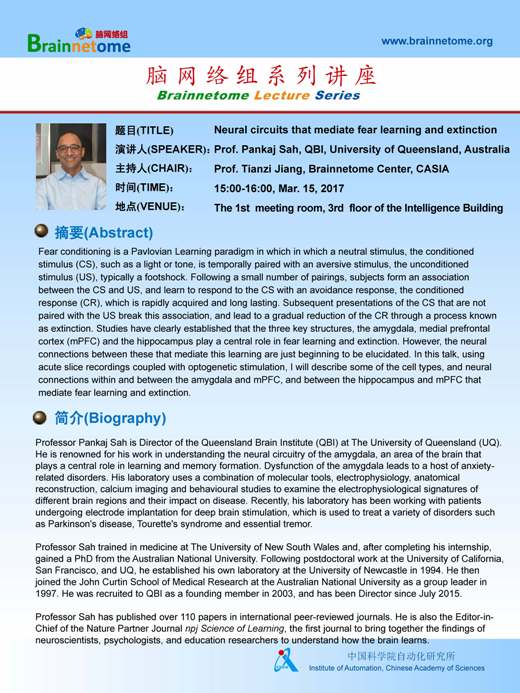Prof. Pankaj Sah's Lecture: Neural circuits that mediate fear learning and extinction
Title: Neural circuits that mediate fear learning and extinction
Speaker: Prof. Pankaj Sah, QBI, University of Queensland, Australia
Chair: Prof. Tianzi Jiang, Brainnetome Center, CASIA
Time: 15:00-16:00 Mar. 15, 2017
Venue: The 1st meeting room, 3rd floor of the Intelligence Building
[Abstract]
Fear conditioning is a Pavlovian Learning paradigm in which in which a neutral stimulus, the conditioned stimulus (CS), such as a light or tone, is temporally paired with an aversive stimulus, the unconditioned stimulus (US), typically a footshock. Following a small number of pairings, subjects form an association between the CS and US, and learn to respond to the CS with an avoidance response, the conditioned response (CR), which is rapidly acquired and long lasting. Subsequent presentations of the CS that are not paired with the US break this association, and lead to a gradual reduction of the CR through a process known as extinction. Studies have clearly established that the three key structures, the amygdala, medial prefrontal cortex (mPFC) and the hippocampus play a central role in fear learning and extinction. However, the neural connections between these that mediate this learning are just beginning to be elucidated. In this talk, using acute slice recordings coupled with optogenetic stimulation, I will describe some of the cell types, and neural connections within and between the amygdala and mPFC, and between the hippocampus and mPFC that mediate fear learning and extinction.
[Biography]
Professor Pankaj Sah is Director of the Queensland Brain Institute (QBI) at The University of Queensland (UQ). He is renowned for his work in understanding the neural circuitry of the amygdala, an area of the brain that plays a central role in learning and memory formation. Dysfunction of the amygdala leads to a host of anxiety-related disorders. His laboratory uses a combination of molecular tools, electrophysiology, anatomical reconstruction, calcium imaging and behavioural studies to examine the electrophysiological signatures of different brain regions and their impact on disease. Recently, his laboratory has been working with patients undergoing electrode implantation for deep brain stimulation, which is used to treat a variety of disorders such as Parkinson's disease, Tourette's syndrome and essential tremor.
Professor Sah trained in medicine at The University of New South Wales and, after completing his internship, gained a PhD from the Australian National University. Following postdoctoral work at the University of California, San Francisco, and UQ, he established his own laboratory at the University of Newcastle in 1994. He then joined the John Curtin School of Medical Research at the Australian National University as a group leader in 1997. He was recruited to QBI as a founding member in 2003, and has been Director since July 2015.
Professor Sah has published over 110 papers in international peer-reviewed journals. He is also the Editor-in-Chief of the Nature Partner Journal npj Science of Learning, the first journal to bring together the findings of neuroscientists, psychologists, and education researchers to understand how the brain learns.

